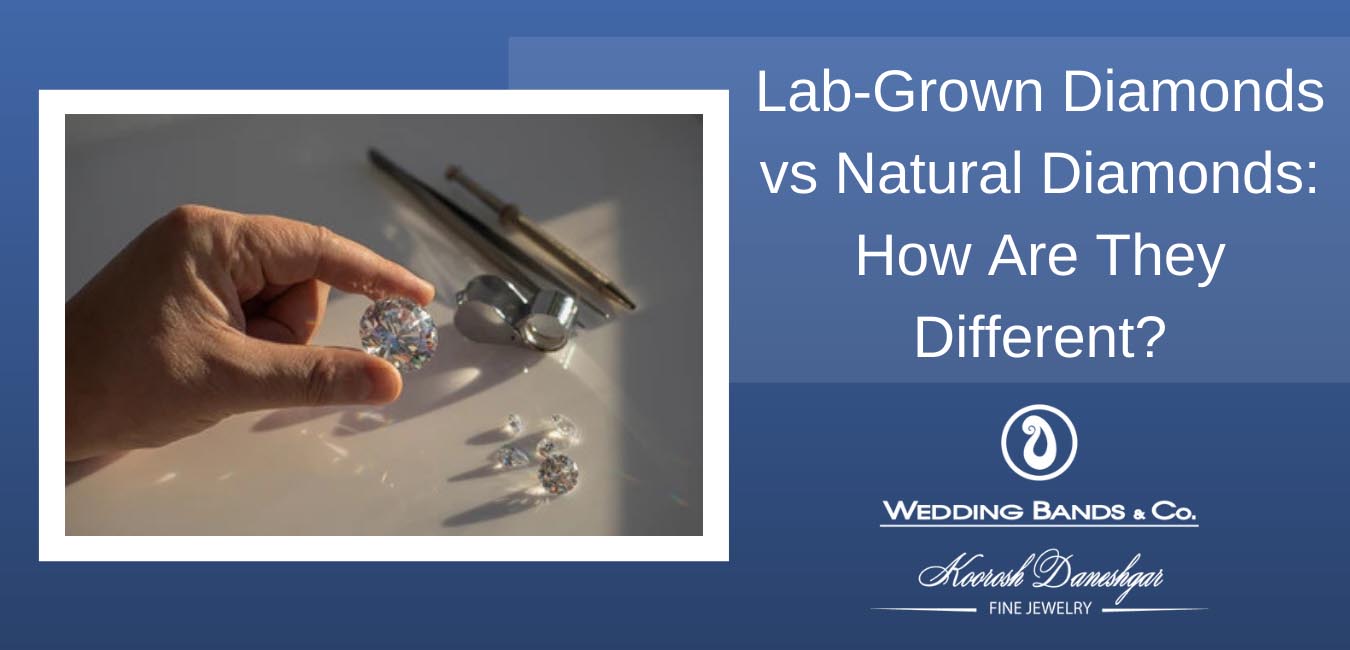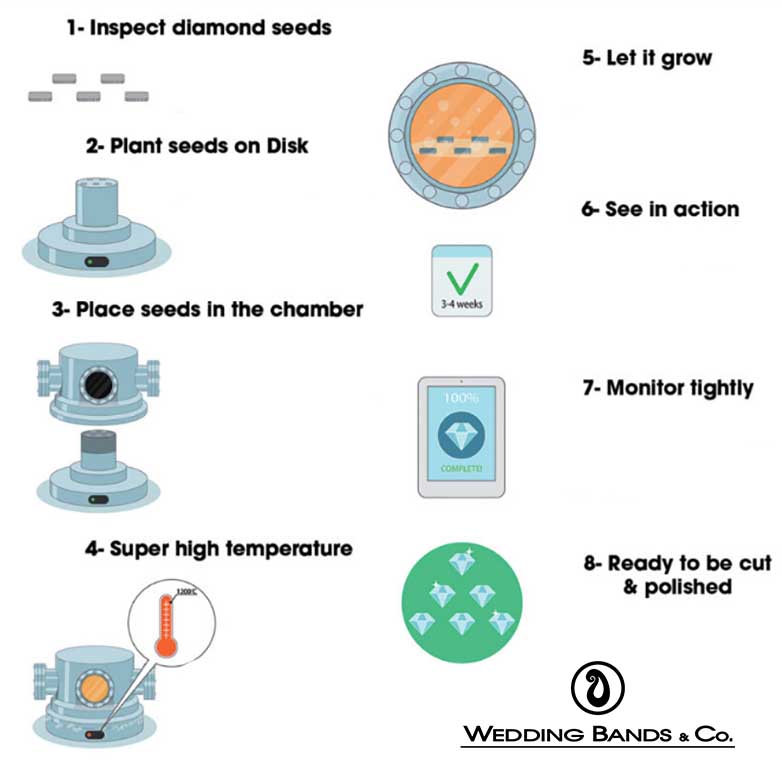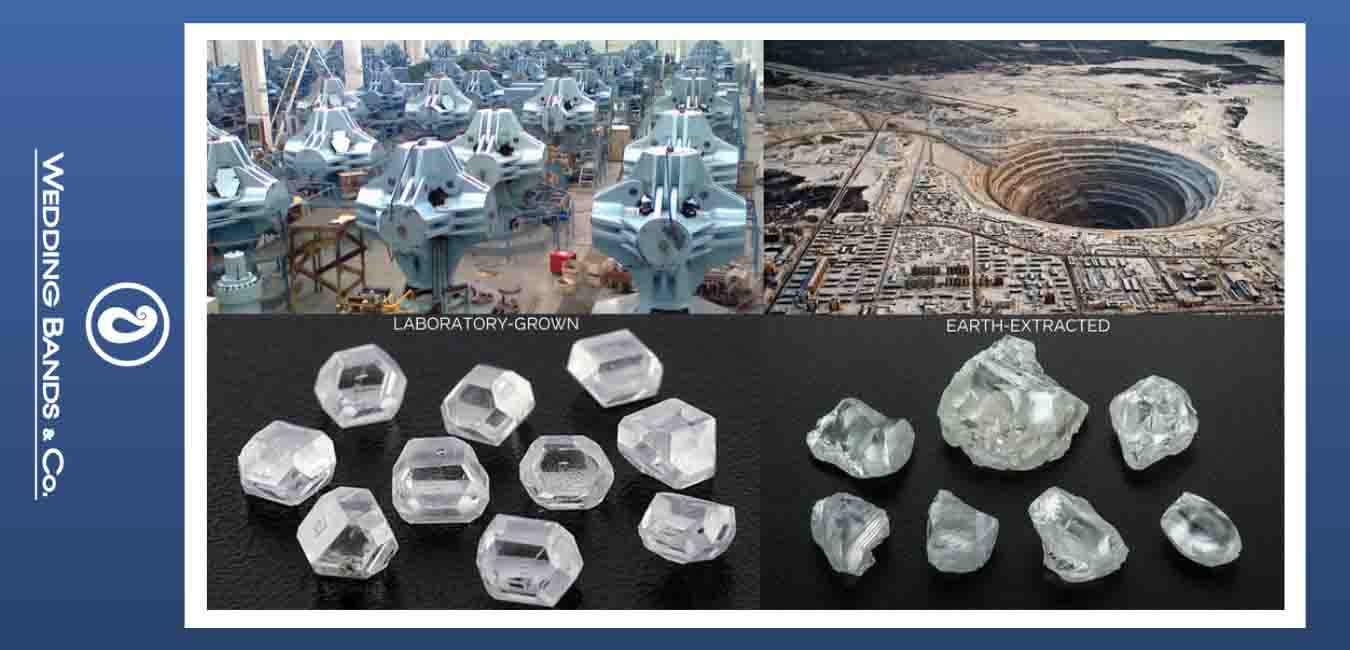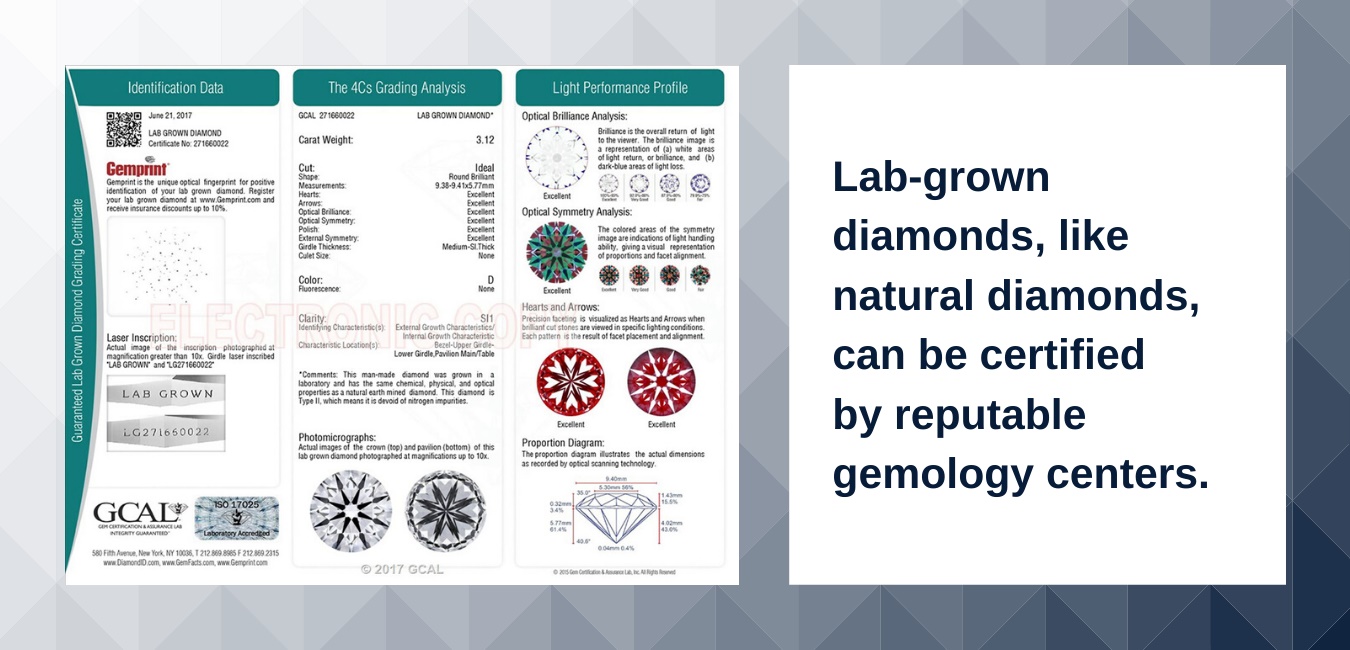Lab Grown Diamonds vs Natural Diamonds: How Are They Different?
Posted by Koorosh Daneshgar on Feb 29th 2020
Lab Grown Diamonds vs Natural Diamonds: How Are They Different?
These days, lab-grown diamonds are widely marketed. Lab diamonds made a new challenge for people who wants to buy engagement rings. In this article, we provide some facts about differences between lab grown diamonds vs natural diamonds to help you choose the best diamond engagement ring.
What Is A Lab Grown Diamond?
Lab-grown diamonds are made from carbon atoms under the strict control of the laboratory environment so that they can rebuild the multi-million-year process of producing diamonds in the natural environment just in a few weeks.
Lab-made diamonds are quite similar in appearance and quality to natural diamonds but are much cheaper than similar natural diamonds because of their abundance and ease of access. Lab-made diamonds have also been referred to as man-made diamonds, engineered diamonds, synthetic diamonds, cultured diamonds, artificial diamonds, and cultivated diamonds.
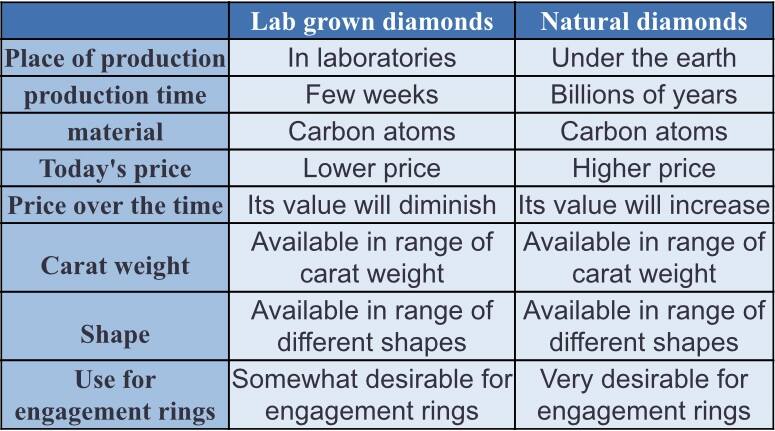
On the one hand, you are going to give your lover the most special and beautiful engagement ring, and on the other hand, you find lab diamonds that claim to look similar to natural diamonds but less expensive. So for sure, there are a lot of questions in your mind about how this is possible? How about the quality of lab-made diamonds? Are they as sparkly as natural diamonds? Is it good to invest in buying a lab diamond for the engagement ring or not? Join us in this article to find the answers to these questions.
How are lab-grown diamonds made?
There are two main production methods for lab diamonds: High Pressure/High Temperature (HPHT) and Chemical Vapor Deposition (CVD).
The High Pressure-High Temperature method, is almost the same way diamonds are grown in the ground. In this process a diamond seed along with carbon in a special microwave room which can provide intense heat and pressure. After few weeks, the diamond seeds will grow into diamonds. At this time diamonds should be laser cut, grind and measured for jewelry. Since this process requires a lot of energy, HPHT is not used as much as CVD.
The beginning of CVD process is the same as HPHT where they put a diamond seed along with carbon on a tungsten disk. At this stage, these seeds are placed in a room filled with hydrogen and methane gas. The chamber will then heated up to extreme temperatures, which excites the gases and causes the diamond to grow upward on the seed crystal. After almost two weeks diamond is ready to be cut, measured and grind. As mentioned earlier, this process is cheaper than HPHT and the result is high quality diamonds that completely measure up to mined diamonds.
Lab-created diamonds used to be utilized only for industrial purposes at first, but the advancement resulted in its current use, which is jewelry. Nowadays, the process is so accurate and identical with the natural one that makes it impossible for even the jewelers to find out whether it is a lab diamond or its mineral counterpart.
Are lab-grown diamonds real diamonds?
Yes! The lab-grown diamonds are real diamonds. The lab-grown diamonds are quite similar to real diamonds in all of their features such as appearance, quality, color, hardness, material, and beauty. As I mentioned above, the process of making a lab-made diamond is carried out by carbon atoms at high pressure and temperature. However, the carbon atoms, high pressure, and high temperature are necessary factors to produce the natural and real diamonds under the earth’s surface.
The conditions for the formation of natural diamonds are similar to those of lab diamonds. The only difference between these two diamonds is the place and time of the process. Natural diamonds formed hundreds of miles beneath the Earth's surface, under high pressure and high temperatures, between 1 to 3 billion years ago, and reached the upper layers of the earth's surface through volcanic explosions. While the lab-made diamonds form during a few weeks in laboratories and by human control.
Lab grown diamonds vs natural diamonds
Lab-grown diamonds are as good as real diamonds. The Gemological Institute of America (GIA) identifies four factors in determining the quality of a diamond. These factors, known as 4Cs, include cut grade, carat weight, clarity, and color. Scientists can control all aspects of the diamond production process in laboratories so they can monitor those four factors to produce a lab-made diamond with the best quality.
If we want to compare the goodness of natural diamond and the lab-grown diamonds we need to look at some of its other features too. For example, diamond hardness is one of the most important factors in determining the quality of a diamond. The interesting point is that the hardness of both natural and lab-created diamonds is equal to 10 on the Mohs scale of hardness. As a result, the lab-grown diamonds are as resistant as real diamonds so they can be cut into many different shapes.
It can be said that the amount of energy consumed in producing a low-quality lab diamond and a high-quality lab diamond is almost equal. So this energy and technology are used to produce diamonds that are as good as natural diamonds in different varieties of shapes, colors and carat weight.
Consequently, we have to admit that the lab-made diamonds are not only as good as real diamonds but they are also classified as real diamonds too.
Are lab created diamonds the same as cubic zirconia?
Cubic zirconia is not diamond. They are only the diamond simulators that look very much like diamonds. Whereas lab-grown diamonds are real diamonds that come from a different origin. There are significant chemical and physical differences between cubic zirconia and lab-grown diamonds.
The constituent of cubic zirconia is ZrO2, while the lab-grown diamond is made of pure carbon. Carbon causes excessive hardness in natural and lab-made diamonds (10 on the Mohs scale of hardness), but the hardness of cubic zirconia is between 8 and 8.5. The lab-made diamonds are significantly more durable than cubic zirconia because of their hardness.
Cubic zirconia is significantly heavier than lab-grown diamonds. The cubic zirconia is usually colorless, but laboratory diamonds are made in different colors. The price of cubic zirconia is also much cheaper than lab-made diamonds.
Cubic zirconia is a kind of fake diamond that looks like a real diamond but has different quality and inner features.
Do lab-grown diamonds sparkle?
Yes, lab-grown diamonds are as sparkly as natural diamonds. There is no difference in the characteristics of natural diamonds and lab-grown diamonds. The sparkle of a diamond depends on the cut grade.
Fortunately, since a lab diamond is made of pure carbon and has an extraordinary hardness, it has no restrictions on cutting. So it is possible to make an excellent cut to provide the best sparkle.
In other words, just as natural diamonds have a variety of shine, color, cut, shape, weight, and other factors, so the lab-created diamonds are produced with the same varieties too.
If you're worried about the sparkle of a lab-grown diamond, the good news is that you can apply the same parameters you would consider when choosing a sparkly natural diamond to select the sparkly lab-grown diamond too. To get acquainted with these parameters, I recommend you read the article in the link below. How to choose a sparkly diamond?
Do Lab-created diamonds get cloudy?
The diamond production process in the lab is completely under control. So it can be expected that lab-grown diamonds are often produced with a high degree of clarity so they get cloudy very rare. Getting cloudy largely depends on the diamond's clarity grade.
As I mentioned above, lab-made diamonds are physically and chemically exactly similar to natural diamonds. So they are as good as natural diamonds in not getting cloudy. Occasionally, a cloudy look on the surface of the diamond may occur when the diamond is too dirty. So you just need to clean the diamond and remove the dirt and oils from its surface and see its sparkle again.
Another reason for the cloudy look of lab-grown diamonds can cause due to exposure to very high heat (which usually occurs when repairing the ring, not in normal use of the diamond). To eliminate this cloudy look, the jeweler can polish the diamond, or if necessary, they can cut the turbid facets of the diamond again.
Are lab-created diamonds better for the environment?
The lab-grown diamonds are more eco-friendly and are better for environmental sustainability. Although the carbon footprint of lab-grown diamonds has not been accurately calculated yet, there are many reasons that environmental activists see diamond production in the laboratory as more environmentally friendly than the extraction of diamonds from nature.
For example, each lab-grown diamond carries between 20 and 28 kilowatt-hours of energy to produce each diamond carat. However, 80.3-kilowatt-hours per carat is used to extract natural diamonds from the earth’s surface. Consuming less energy, on the one hand, preserves the environment's non-renewable energy sources and, on the other hand, it will make less pollution. Of course, lower energy consumption keeps the cost of diamond production lower too.
Another advantage of the lab-grown diamonds is that there is no need for excavation, Road Construction, mountain displacement, and groundwater degradation to produce lab-made diamonds. Sometimes natural diamonds are about two miles underground. Miners have to face harsh working conditions to extract diamonds, while mining can damage the earth's physical features too. On the other hand, they may extract hundreds of diamonds and only a few of them are in match with market standards, and one of the reasons for the high price of diamonds is its rareness.
While diamond production in laboratories is done without damaging the appearance of the earth's surface at this wider level, diamond laboratory workers have better occupational safety and health than miners, and most of the diamonds produced are functional and qualified.
Can you tell the difference between a lab-grown diamond and a real diamond?
The only difference between the lab-grown diamond and real diamond is the difference in their origin. Lab-made diamonds are manufactured in special chambers with human control. But natural diamonds spontaneously formed deep inside the earth.
However, it takes several weeks to synthesis the lab-created diamonds, while natural diamonds take millions of years. Ultimately, what matters is that the final product of the lab-grown diamond process is a real diamond, not a fake diamond .
There is no visual difference between lab-grown diamonds and real diamonds. The physical, chemical and optical properties of both of them are the same as each other. It is impossible to recognize the differences with naked eyes.
On the other hand, as I mentioned above, there is no difference between the constituent material and the potential conditions in the production of lab-grown diamonds and natural diamonds. Both diamonds are made from carbon atoms.
This process is at high temperatures and under high pressure both in nature and lab. So the quality of these two types of diamonds is similar. Even professional gemologists cannot recognize the difference between them without using some special tools.
Can lab-grown diamonds be certified?
Lab-grown diamonds, like natural diamonds, can be certified by reputable gemology centers. These gemology centers such as the Gemological Institute of America (GIA), the Gem Certification & Assurance Lab (GCAL), the International Gemological Institute (IGI), and the European Gemological Laboratory (EGL) can certify lab-made diamonds weighing more than half a carat.
The lab-grown diamond's certification, not only contains important information about the diamond such as the grade of cut, the carat weight, color, clarity, etc. but even it shows the technology that used to diamond synthesis. For example, you can understand from the lab-made diamond certification that this lab-grown diamond has been synthesized via the chemical vapor deposition (CVD) technique or by the high-pressure-high-temperature (HPHT) synthesis technique.
So for sure, there are a lot of questions in your mind about how this is possible? It doesn't matter if you want to buy lab diamonds or natural diamonds. Since the detection between a real diamond and the fake diamonds is very professional and accurate work and as it requires years of experience and specialized experts and tools to recognize the quality of the real diamonds, so we strongly recommend you to buy diamonds from reputable jewelers who also provides diamond certification.
The trustworthy diamond stores guarantee the value and quality of the diamond with providing the diamond certification and on the other hand, you also make sure about not paying extra money.
As you can see the diamond certification is an important feature to ensure the quality and credibility of the diamond. If you need to learn more about this issue I suggest you check out this link and read the article to learn lots of detailed information about the independent diamond certifications: What is an independent diamond certificate?
Lab-grown diamond engagement ring
We are not here to encourage you to buy a specific type of diamond or discourage you to buy another kind of diamond for the engagement ring. In our opinion, you should choose the engagement ring according to the personality and interests of your partner and your wedding budget. Lab-grown diamonds are physically, chemically, and optically similar to natural diamonds.
The advantages of lab-grown diamonds for the engagement ring:
Its lower price
If you have a limited budget, the lab-grown diamonds are a good choice for you. The lab-made diamonds are glorious and unique but they have lower prices too. So it can be a good option for those couples who want to have diamond engagement rings and also have financial constraints. By choosing a lab diamond ring they can also pay for a larger diamond at a lower cost.
The environmental considerations
Some couples are not interested in buying natural diamonds because they want to protect the environment by another selection, but on the other hand, they like to have a diamond ring too. In this case, buying a lab-grown diamond is a good choice.
The disadvantages of lab-grown diamonds for the engagement ring:
Not for investment
The first thing to consider when buying a lab-grown diamond is its resale value. Lab-grown diamonds do not have the same resale value as mined-diamonds. If you want to know more information about lab-grown diamonds price, check this blog.
It is not rare
Most couples try to have a unique engagement ring. Although the variety of lab diamonds is huge, it is nevertheless dependent on technology development. So after a few times, you may see lots of lab-made diamonds the same as your engagement ring in the stores at a lower price. To avoid this problem, you can consult with a jewelry designer to design a special engagement ring for you.
Based on the experience I can say that diamond is the best gem for the engagement ring in terms of hardness, beauty, sparkle and other factors. (We explained this in detail in another article that you can see here:
Why are diamonds the best gemstone for an engagement ring?
On the other hand, the lab-grown diamonds are real diamonds too and offer the same quality and beauty. Now it is your choice whether to choose a lab-created diamond based on what I mentioned above or to choose a natural diamond. Just consider your personality, budget, and any personal reasons to make the best choice between a real diamond and a lab-grown diamond.
Where can I buy lab-grown diamonds in Chicago?
If you're looking for a lab-grown diamond for the engagement ring in Chicago then be sure to check out the Chicago Jewelers Row. The Jewelers Row, or Chicago diamond district, is a well-known place between couples who want to buy a diamond engagement ring in Chicago.
There are hundreds of reputable jeweler stores in the Jewelers Row that offer a wide variety of qualified diamonds. Another benefit of going to the Jewelers Row is that you can compare the variety of prices and jewelers to make the best choice for the engagement ring.
The wedding band company is one of the best stores in Jewelers Row. Our company with over 30 years of experience can provide you a variety of diamonds including both lab-made diamond and natural diamonds. We can help you to design the perfect engagement ring based on your interests and personality. In the wedding band company, you can see the actual stone and compare it with other natural and man-made diamonds before the purchase.
The wedding band company’s showroom is located at 43 E Oak St. fl 2, Chicago, IL 60611.
Nothing more than consulting with experts and the ability to review a range of diamonds can help you in the process of choosing an engagement ring, which of course our company provides these options. For more information and to see the different options offered by Wedding band company, check out the link below. Where should I buy a diamond engagement ring?
Frequently Asked Questions:
How much are lab-grown diamonds?
Generally, the price of a lab diamond is significantly cheaper than a natural diamond. The pricing of the lab-grown diamond depends on many factors (same as natural diamonds). Cut grade, carat weight, color, and clarity are the most important determinants in diamond pricing.
As the lower cost of producing lab diamonds, so the final price is also cheaper. It even reaches about one-third of the price of natural diamonds in rare colors. It is estimated that the price of diamonds will drop annually.
How to identify lab-grown diamonds?
Only professional gemologists in their laboratories can identify lab-grown diamonds with special tools and different gem tests. Identifying the authenticity of a lab-grown diamond is impossible for common people. There is no difference in appearance or chemical material between natural and lab-made diamonds. So even expert people cannot identify the differences with the naked eye.
Can a jeweler tell if a diamond is a lab-created?
Even the jewelers cannot tell about the origin of the diamond. Only the laboratories can identify these differences between lab-grown diamonds or natural earth-grown diamonds. The jeweler’s tools and equipment are designed to recognizing real diamonds from fake diamonds, while the lab-created diamonds are real diamonds too.
Why should I come to you to design my ring?
We involve you in every step of the process. At first, we will sit next to you and go over any concerns you have and any specific design elements you mind the ring to have. Once we have established exactly how you want the ring looks like, we will proceed with the design process. Once you see this design, if you want to make any change or if you have any questions or concerns we will be happy to address them for you. Our role is to help you to create the perfect ring and that means we will listen to you and make sure that your ring is indeed one of a kind.
We'll help you to design your dream engagement ring without stress and spending countless hours searching for your perfect ring. All you need to do is click on "Free Consultation" to get started.
By: Koorosh Daneshgar CEO/Design Chief


